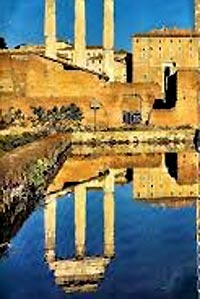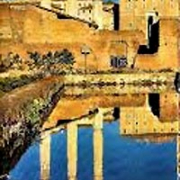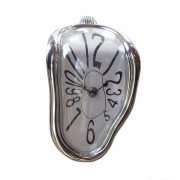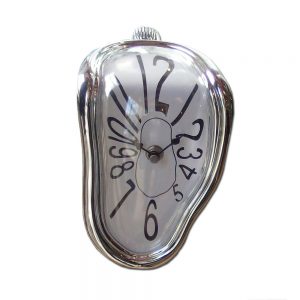MONTHLY BLOG 151, Reflections upon Roaming in Rome, after a Return Visit to The City
If citing, please kindly acknowledge copyright © Penelope J. Corfield (2023)

|
Reflected Images of Classical Rome – |
Rome is a matchless city for reflective walkers.1 Ok – best to choose a time of year when the heat is not too intense. And essential not to be in a hurry. But for those who like to stroll, to take in the views, and to reflect upon the workings of time, Rome is matchless.
Superb buildings of all eras are juxtaposed. Some are grand and justly famous. Other beautiful edifices remain relatively unknown, although elsewhere they would be celebrated tourist attractions in their own right. Everywhere there are new vistas to admire; new angles to explore.
Some areas are very crowded – try the zippy evening atmosphere of Trastevere, situated just across the river from the old centre – but there are also high places that offer peaceful panoramas of the cityscape as a whole.
Famously, the city was built upon the ‘seven hills’ of Rome, clustered together in a big bend of the River Tiber. In reality, however, there are more than seven vantage points, as other hills form an irregular wider ring around the centre. My personal favourite is the Gianicolo Hill (the Roman Janiculum). It is situated behind Trastevere, to the west of the old centre. It is not too crowded with visitors. And the views from the top are stunning – try checking the scene from the hilltop piazza with a huge bronze equestrian statue of Giuseppe Garibaldi.
Monuments in Rome are both secular and religious, offering reminders of its past role as an imperial capital – and its continuing role as the headquarters of an international faith, Indeed, the Vatican City was granted jurisdictional autonomy in 1870, when the previous Paper Sates were absorbed into the newly united Kingdom of Italy. Walkers through the Roman streets are thus reminded everywhere of the power that spiritual beliefs can generate.
And, to underline the point, Rome is awash with churches. My personal favourite is the Santa Maria d’Aracoeli. It is one of the oldest Christian churches in the city – and it was pointedly sited on top of the Capitoline Hill, at the physical heart of the Roman Empire. Moreover, the Romanesque edifice features columns that were scavenged from nearby imperial ruins. It was here in 1764, whilst listening to monks chanting in this church, and simultaneously gazing at the surrounding ruins of the once-mighty imperial capital, that the English historian Edward Gibbon first conceived his plan of writing an in-depth analysis of The Decline and Fall of the Roman Empire (1776).2
Yet the twists and turns of fortune remain unending. Between 1885 and 1935, successive Italian governments supported a further massive new construction adjacent to the same Capitoline Hill. It is named the Monument to Victor Emmanuel II (the first king of united Italy) – also known as the Vittoriano – and sometimes – irreverently – as the ‘wedding cake’. This eye-catching edifice, with its grand flights of stairs, colonnades, and statues, dominates the site and skyline as a secular neo-classical tribute to celebrate Italian Unification. The king himself is not buried here. Instead, the building contains the tomb of Italy’s ‘unknown soldier’.
But what has happened to the old church? It is still there but not easily visible. It’s set back, tucked up and behind the west flank of the Vittoriano. Walkers have to go round the Vittoriano to find a long flight of steps and then climb up to visit the unadvertised church in its historic glory. So historians can now ponder the fluctuating fortunes of townscapes and monuments, as well as those of empires, kingdoms, and religions.
Lastly, walkers in Rome must keep their eyes open. The pavements are irregular and often narrow. They may give way to uneven steps. Stone pathways can be slippery. Tourist crowds can jostle. Traffic is unpredictable. Yet everywhere there are fountains by which to linger – and bars selling fine Italian ice-cream. My favourite place for an evening drink is the Piazza Navona. Its Baroque splendour is superimposed upon the unchanged layout of the sporting stadium built for the Roman Emperor Domitian. Another great monument to time and change! ‘Eternal’ Rome survives by constant updating: not to stay the same; nor to shed the past; but to stay both historic and alive.
ENDNOTES:
1 See the classic account by Stendhal (1783-1842), Promenades dans Rome (Paris, 1829), available in English as A Roman Journal, ed. and transl. by H. Chevalier (London, 1959). And for a contemporary guide, see J. Fort and R. Piercey, Rome Walks (London, 2011).
2 For E. Gibbon (1737-94), author of The History of the Decline and Fall of the Roman Empire, 6 volumes (1776-88), see C. Roberts, Edward Gibbon and the Shape of History (Oxford, 2014); plus K. O’Brien and B. Young (eds), The Cambridge Companion to Edward Gibbon (Cambridge, 2018).
For further discussion, see Twitter
To read other discussion-points, please click here
To download Monthly Blog 151 please click here



 Historians, who study the past, don’t undertake this exercise from some vantage point outside Time. They, like everyone else, live within an unfolding temporality. That’s very fundamental. Thus it’s axiomatic that historians, like their subjects of study, are all equally Time-bound.1
Historians, who study the past, don’t undertake this exercise from some vantage point outside Time. They, like everyone else, live within an unfolding temporality. That’s very fundamental. Thus it’s axiomatic that historians, like their subjects of study, are all equally Time-bound.1